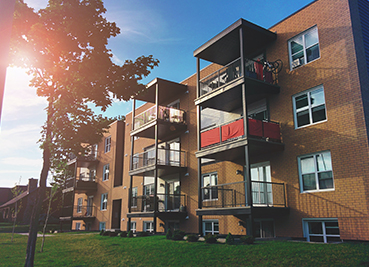
As seen in Denver Business Journal
Construction slowdown should bring down elevated vacancy rate
The long-awaited cut in interest rates that came last week was largely celebrated by commercial real estate investors and developers, with many saying the news signals a much-needed turning of the tide for the industry.
The Federal Reserve on Sept. 18 said it was lowering the target range for the federal funds rate by half a percentage point, a more aggressive cut than many industry watchers were expecting for the Fed’s September meeting. The cut is widely expected to unlock liquidity in commercial real estate financing and, in some cases, spur deals that were unable to pencil even just a week ago.
The aggressive rate hikes the Fed imposed beginning in 2022 in response to high inflation and a hot labor market have had a crippling effect across CRE dealmaking — whether buying and selling properties, refinancing a loan, obtaining new debt, or moving forward on new development.
“When we’re talking about interest rates, it’s only as good as lenders willing to lend, and the banks’ willingness to lend to investors and developers other than their best clients,” said Mark Rose, CEO of commercial real estate firm Avison Young. “That’s really what’s been holding us up.”
Based on the Fed’s action last week and the potential for another rate cut before the end of the year, Rose said it sets commercial real estate up for a recovery from the current economic cycle by mid-2025. It’s a cycle that has been beset by high interest rates, muted office attendance and saturation of multifamily supply.
That said, recoveries take a little bit of time, Rose said, and commercial real estate is an industry that tends to have a little bit of lag time.
“There’s nothing but goodness in what happened [last week],” he said. “There’s a chance that pent-up demand at all levels, including traditional lending sources, could come about in the fourth quarter. Incrementally, we’re moving to a recovery that probably looks like mid-year next year.”
Across commercial real estate, last week’s rate cut is a huge windfall for anyone who needs to refinance any asset, Rose said.
Barry Lapides, a partner at Berger Singerman LLP who specializes in commercial real estate law, said when rates go down, it’s a positive thing overall for developers, investors and syndicators.
“The interest-rate cut is Christmas for real estate investors and borrowers,” Lapides said. “For people who have existing loans that are either coming due or rate caps that are expiring and they need to purchase new rate caps, this is … a gift.”
Richard Barkham, global chief economist and head of Americas research at CBRE Group Inc. (NYSE: CBRE), said during a media briefing last week the rate cut will be welcomed by the real estate community. CBRE expects the Fed to reduce the federal funds rate by an additional 25 basis points in both November and December, followed by 125 basis points in cuts in 2025.
In particular, last week’s rate cut and the expectation of further cuts in the coming months will impact the CRE capital markets, which have been largely locked up since 2022. In the second quarter, $40.1 billion transacted across major property types in the U.S., down 9.4% from the same quarter the prior year, although up 13.9% from Q1 2024, according to Altus Group data.
Property values in some sectors have fallen between 20% and 30% in the past 36 months, Barkham said. But even before last week’s Fed meeting, there’s been a marked change in sentiment, he said.
“I would say rents are holding steady, real estate values have stabilized and, in some sectors, are probably firming,” Barkham said. “2025 looks set for a good rebound in capital-markets activity, which, of course, means [capitalization] rates have peaked and are likely to fall over the course of the next 12 months.”
What happens to all of that CRE distress?
While the interest-rate cut and further actions by the Fed in the coming quarters are largely positive news for commercial real estate, rate reductions won’t solve all of the industry’s problems.
Commercial real estate loan delinquencies among industry lenders continue to pile up, and the loan-delinquency or distress rate of assets like office and multifamily have risen in the past several quarters.
S&P Global Intelligence recently found the average interest rate on commercial real estate loans that originated this year is 6.2%, compared to an average 4.3% on mortgages that are about to mature. That’s nearly a 200 basis-point difference, a gap that obviously won’t be covered by a 50 basis-point rate cut.
Some industry insiders are skeptical about how much last week’s rate cut will broadly impact the sector.
Laura Swihart, co-chair of Dechert LLP’s global finance and real estate practice groups, said in a statement borrowers and investors have become more accustomed to the current interest-rate climate and adjusted valuations over the last month or so. That’s resulted in more deal flow and investor interest.
“The additional dip in rates will, of course, help to continue this trend, but I don’t believe it will be enough to have a significant impact on certain highly impacted asset classes, such as B and C class office space in troubled geographical areas,” she said.
Darin Mellott, vice president and head of U.S. capital-markets research at CBRE, similarly said during last week’s media briefing that lower interest rates will minimize but won’t fully eliminate distress in the industry.
“It’s important to look at the long end of the yield curve,” Mellott said. “As we get closer to that 3.5% range in the 10-year [Treasury rate], those lower interest rates will solve a lot of problems with a lot of assets. We are absolutely going to continue to see some distress, particularly in the office sector.”
Lapides of Berger Singerman said the impact of the rate cut on each asset class will be different — and for office properties in particular, it’s not certain the cut will do much at all.
“It’s helpful, but a 50 basis-point drop is not all of a sudden going to swing an investment from doubtful to doable, simply because of the rate drop,” he said. “The developers need to see a home run in order to move forward with an office deal as opposed to multifamily.”
On the other hand, for a sector like multifamily, which has more recently begun to see more distress creep in, the rate cut has a bigger impact, Lapides and others said.
Rose of Avison Young said there will be the “haves and have nots” in commercial real estate beyond interest rates. For example, the cost of insurance and real estate taxes have created additional stress for properties already suffering from rising costs, less cash flow, occupancy issues and — before Wednesday — higher interest rates.
Investors that have access to more money to pay down debt or take out slightly lower balances will generally be fine, Rose said. But if, for example, a Class B building hasn’t been renovated or retrofitted, has an occupancy rate of 60% or 70%, is facing higher insurance and tax costs, and has debt coming due, a 50 basis-point rate cut will not solve those challenges.
“[The impact] will continue to be product by product, country by country, city by city,” Rose said.
Cuts impact multiple lines of business
For BEB Capital, a Port Washington, New York-based commercial real estate investor and lender, last week’s rate cut is meaningful for both sides of its business.
“As it relates to our equity portfolio and acquisitions and growth strategy there, I think this starts to unlock the inertia and difficulty within the capital markets, which will allow more transactions to be done,” said BEB Capital CEO Lee Brodsky. “We see this as a once-in-a-generation buying opportunity. This starts that process.”
He said the property types BEB Capital will look to capitalize on include two of its core investments — multifamily and industrial. But, Brodsky said, there’s also an opportunity to be part of “a real healing story” in the office market.
Keyvan Ghaytanchi, chief investment officer at BEB Capital, said the rate cut helps provide stability for alternative lenders like BEB, especially as banks have been hesitant to lend to commercial real estate not only because of high interest rates, but also because of the regulatory scrutiny being placed on CRE lenders.
Still, rate cuts will help longer-term assets match short-term liabilities on returns, making takeouts easier and more probable.
“This will allow us to originate more loans and be more confident in those takeouts,” Ghaytanchi said.
The Fed’s move to a rate-reduction campaign also will allow the firm to more easily evaluate assets and the underlying collateral, he said.
Despite last week’s activity, many still wonder whether the soft landing the Fed has been hoping to achieve with its interest-rate strategy will actually be achieved. While the outlook has become more optimistic after last week’s meeting, there are other levers in the broader economy that could mean a recession or downturn is imminent.
Commercial real estate executives largely say those concerns are overblown, although broader economic patterns and trajectories are still being closely watched.
“It looks like we’re heading toward a soft landing,” Ghaytanchi said. “I think industrial will be fine, and we will have continued demand from businesses as they grow, especially given near-shoring. The rate cuts will probably benefit multifamily the most, as a lot of those loans were floating-rate loans. I don’t know if it’s enough to completely rescue some of the lenders or sponsors who had a lot of issues. Much deeper cuts will be needed to rescue the heavily levered assets.”




